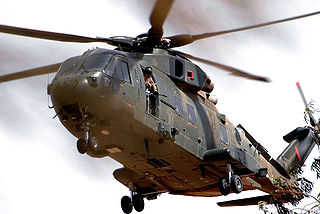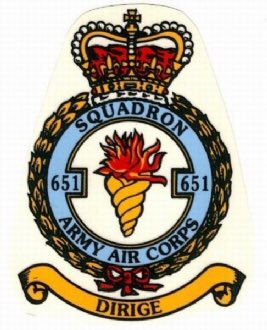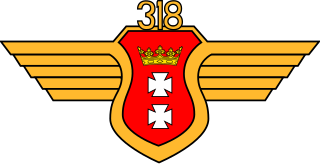
No. 1419 Flight RAF was a flight within the Royal Air Force.
No. 652 Squadron RAF was a unit of the Royal Air Force during the Second World War and afterwards in Germany. Numbers 651 to 663 Squadrons of the RAF were air observation post units working closely with Army units in artillery spotting and liaison. A further three of these squadrons, 664, 665 and 666, were AOP units of the Royal Canadian Air Force manned by Canadian and British personnel. Their duties and squadron numbers were transferred to the Army with the formation of the Army Air Corps on 1 September 1957.
No. 661 Squadron was a Royal Air Force air observation post squadron associated with the Canadian 1st Army and later part of the Royal Auxiliary Air Force. Numbers 651 to 663 Squadrons of the RAF were air observation post units working closely with Army units in artillery spotting and liaison. A further three of these squadrons, 664–666, were manned with Canadian personnel. Their duties and squadron numbers were transferred to the Army with the formation of the Army Air Corps on 1 September 1957.

No. 662 Squadron was a Royal Air Force air observation post squadron associated with the 21st Army Group and later part of the Royal Auxiliary Air Force. Numbers 651 to 663 Squadrons of the RAF were air observation post units working closely with Army units in artillery spotting and liaison. A further three of these squadrons, 664–666, were manned with Canadian personnel. Their duties and squadron numbers were transferred to the Army with the formation of the Army Air Corps on 1 September 1957. It is now an Apache Helicopter Squadron.

No. 651 Squadron Army Air Corps, is an aircraft squadron of the British Army, originally formed as No. 651 Squadron Royal Air Force in Italy and North Africa during the Second World War, and afterwards in Egypt. Numbers 651 to 663 Squadrons of the RAF were air observation post units which had both Army and RAF personnel. The pilots, drivers and signallers were in the Royal Artillery whilst the adjutants, technical staff and equipment officers came from the RAF. Air observation posts were used primarily for artillery spotting, but occasionally for liaison and other duties. Their duties and squadron numbers were transferred to the Army with the formation of the Army Air Corps on 1 September 1957.

No. 550 Squadron RAF was a heavy bomber squadron of the Royal Air Force during World War II. Formed at RAF Waltham on 25 November 1943, 550 Squadron flew Avro Lancaster bombers as part of No. 1 Group RAF. In early 1944, the squadron was moved to RAF North Killingholme, Lincolnshire where it continued operations until May 1945, when it began dropping food over the Netherlands as a relief effort as part of Operation Manna. The squadron was disbanded on 31 October 1945. Today, a surviving Lancaster bomber continues to fly in the markings of BQ-B "Phantom of the Ruhr" EE139 from 550 squadron as part of the Battle of Britain Memorial Flight.

No. 1300 (Meteorological) Flight was formed on 31 July 1943 at RAF Alipore, West Bengal, British India, by re-designating No. 1 Meteorological Flight RAF. The flight, strength of which had been reduced to three Hawker Hurricane Mk.IIs by this time, was disbanded on 30 May 1946 at RAF Kallang, Malaya, as No. 1300 Flight, THUM standing for Temperature and Humidity.
No. 654 Squadron RAF was a unit of the Royal Air Force during the Second World War. Numbers 651 to 663 Squadrons of the RAF were air observation post units working closely with Army units in artillery spotting and liaison. Their duties and squadron numbers were transferred to the Army with the formation of the Army Air Corps on 1 September 1957.
No. 656 Squadron RAF was an air observation post unit of the Royal Air Force in India and Burma during the Second World War and afterwards in British Malaya. Numbers 651 to 663 Squadron of the RAF were air observation post units working closely with British Army units in artillery spotting and liaison. Their duties and squadron numbers were transferred to the Army with the formation of the Army Air Corps on 1 September 1957 With this it became 656 Light Aircraft Squadron Army Air Corps.

No. 657 Squadron RAF was a unit of the Royal Air Force in North Africa, Italy and the Netherlands during the Second World War and afterwards in Germany. Numbers 651 to 663 Squadrons of the RAF were air observation post units working closely with British Army units in artillery spotting and liaison. Their duties and squadron numbers were transferred to the Army with the formation of the Army Air Corps on 1 September 1957.
No. 621 Squadron RAF was a reconnaissance squadron of the Royal Air Force during World War II, flying from Somaliland and Aden. It was after the war stationed in Egypt and Palestine and tasked with air-sea rescue and was also active in Operation Sunburn, looking for illegal immigrants.
No. 1 Photographic Reconnaissance Unit was a flying unit of the Royal Air Force, first formed in 1940.

No. 1451 (Fighter) Flight was formed at RAF Hunsdon, Hertfordshire on 22 May 1941, equipped with Turbinlite Douglas Boston and Douglas Havoc aircraft. On operations they co-operated at first with Hawker Hurricanes of No. 1422 Flight RAF and later with Hurricanes of 3 Squadron. The flight was replaced with 530 Squadron on 8 September 1942 but officially disbanded as late as 25 January 1943.

No. 1454 (Fighter) Flight was formed at RAF Colerne, Wiltshire on 27 June 1941, equipped with Turbinlite Douglas Boston and Douglas Havoc aircraft. By 26 January 1942 the flight moved to RAF Charmy Down, Somerset. On operations they co-operated with the Hawker Hurricanes of 87 Squadron, which also flew from Charmy Down. The flight was replaced with 533 Squadron on 8 September 1942 but officially disbanded as late as 31 January 1943.

No. 1456 (Fighter) Flight was formed at RAF Honiley, Warwickshire on 24 November 1941, equipped with Turbinlite Douglas Boston and Douglas Havoc aircraft. On operations they cooperated with the Hawker Hurricanes of 257 Squadron. The flight was replaced with 535 Squadron on 2 September 1942 but officially disbanded as late as 25 January 1943.

No. 1460 (Fighter) Flight was formed at RAF Acklington on 15 December 1941, equipped with Turbinlite Douglas Boston and Douglas Havoc aircraft. The flight became operational in May 1942 and made its first and only contact with the enemy in June of that year. On operations they cooperated first with the Hawker Hurricanes of 43 Squadron and later with those of 1 Squadron. The flight was replaced with 539 Squadron on 2 September 1942 but officially disbanded as late as 23 January 1943.

No 279 Squadron RAF was a Royal Air Force air-sea rescue squadron of World War II. The squadron was formed on 16 November 1941 and disbanded on 10 March 1946.
No. 244 Squadron RAF was a Royal Air Force Squadron formed as an anti–submarine unit in World War I and a bomber and anti-submarine unit in the Middle East in World War II.

No. 318 "City of Gdańsk" Polish Fighter-Reconnaissance Squadron (Polish: 318 Dywizjon Myśliwsko-Rozpoznawczy Gdański") was a Polish tactical reconnaissance aircraft squadron formed in Great Britain as part of an agreement between the Polish Government in Exile and the United Kingdom in 1940. It was one of several Polish squadrons fighting alongside the Royal Air Force (RAF) during World War II.

RAF Iceland is a former Royal Air Force command which controlled RAF units within Iceland. The command was operational between July 1941 and July 1945 during the Second World War, the unit was previously No. 30 Wing RAF.











